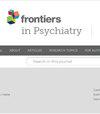Association of diastolic and systolic blood pressure with depression: a cross-sectional study from NHANES 2005-2018
IF 3.2
3区 医学
Q2 PSYCHIATRY
引用次数: 0
Abstract
BackgroundMany studies worldwide have reported the association between mental health and blood pressure, but the results are mixed, and even contradictory. We aim to investigate the relationship between systolic and diastolic blood pressure and depression in the entire US population.MethodsThis study analyzed cross-sectional data from the National Health and Nutrition Examination Survey (NHANES) from 2005 to 2018. All adults completed 3-4 blood pressure measurements after sitting quietly for 5 minutes. Depression was diagnosed based on the Patient Health Questionnaire (PHQ-9), with a score ≥10 defined as depression. Weighted logistic regression and restricted cubic splines (RCS) were used to assess the relationship between blood pressure and depression. Two-piecewise linear regression was used to determine the inflection point. Additionally, subgroup analyses and interaction tests were conducted to identify potential subgroups. Finally, two sensitivity analyses were conducted.ResultsA total of 26,581 American adults were included, with a mean age of 47.2 years, of whom 13,354 (49.54%) were male; 2,261 individuals were defined as depressed, with a weighted prevalence of 7.41%. All participants’ mean systolic blood pressure (SBP) was 121.7 mmHg, and the mean diastolic blood pressure (DBP) was 70.9 mmHg. RCS showed a nonlinear association between SBP and depression, while DBP showed a positive linear association with depression. Two-piecewise linear regression showed that the inflection point of the association between SBP and depression was 129.7 mmHg. Weighted logistic regression showed that after fully adjusting for depression-related risk factors, there was a significant positive correlation between per 10 mmHg increase in DBP and depression (OR: 1.06, 95% CI: 1.00-1.12, P=0.04); however, only on the left side of the inflection point, SBP tended to decrease the odds of depression (P =0.09). Furthermore, interaction analysis showed that the association between DBP and depression was significantly stronger in cancer patients (P for interaction=0.02); on the left side of the inflection point (<129.7 mmHg), current smokers also significantly interacted with SBP (P for interaction=0.018). Finally, two sensitivity analyses also supported our findings.ConclusionIn the adult population of the United States, there is a positive linear association between DBP and depression, while the association between SBP and depression exhibits a significant threshold effect, maintaining SBP at 129.7 mmHg is associated with the lowest prevalence of depression.舒张压和收缩压与抑郁症的关系:2005-2018 年 NHANES 横断面研究
背景全世界有许多研究报告了心理健康与血压之间的关系,但结果不一,甚至相互矛盾。我们旨在调查整个美国人口中收缩压和舒张压与抑郁症之间的关系。方法本研究分析了 2005 年至 2018 年美国国家健康与营养调查(NHANES)的横断面数据。所有成年人在静坐 5 分钟后完成 3-4 次血压测量。根据患者健康问卷(PHQ-9)诊断抑郁症,得分≥10分为抑郁症。加权逻辑回归和限制性立方样条(RCS)用于评估血压与抑郁之间的关系。双片式线性回归用于确定拐点。此外,还进行了亚组分析和交互检验,以确定潜在的亚组。结果 共纳入 26,581 名美国成年人,平均年龄为 47.2 岁,其中 13,354 人(49.54%)为男性;2,261 人被定义为抑郁症患者,加权患病率为 7.41%。所有参与者的平均收缩压 (SBP) 为 121.7 mmHg,平均舒张压 (DBP) 为 70.9 mmHg。RCS 显示,SBP 与抑郁之间存在非线性关系,而 DBP 与抑郁之间存在正线性关系。分段线性回归显示,SBP 与抑郁之间的关联拐点为 129.7 mmHg。加权逻辑回归显示,在完全调整抑郁相关风险因素后,DBP 每增加 10 mmHg 与抑郁之间存在显著的正相关性(OR:1.06,95% CI:1.00-1.12,P=0.04);然而,只有在拐点左侧,SBP 有降低抑郁几率的趋势(P=0.09)。此外,交互作用分析表明,癌症患者的 DBP 与抑郁之间的关联明显更强(交互作用的 P=0.02);在拐点左侧(<129.7 mmHg),当前吸烟者与 SBP 也有显著的交互作用(交互作用的 P=0.018)。结论 在美国成年人群中,DBP 与抑郁症之间呈正线性关系,而 SBP 与抑郁症之间的关系则表现出显著的阈值效应,将 SBP 保持在 129.7 mmHg 与抑郁症发病率最低有关。
本文章由计算机程序翻译,如有差异,请以英文原文为准。
求助全文
约1分钟内获得全文
求助全文
来源期刊

Frontiers in Psychiatry
Medicine-Psychiatry and Mental Health
CiteScore
6.20
自引率
8.50%
发文量
2813
审稿时长
14 weeks
期刊介绍:
Frontiers in Psychiatry publishes rigorously peer-reviewed research across a wide spectrum of translational, basic and clinical research. Field Chief Editor Stefan Borgwardt at the University of Basel is supported by an outstanding Editorial Board of international researchers. This multidisciplinary open-access journal is at the forefront of disseminating and communicating scientific knowledge and impactful discoveries to researchers, academics, clinicians and the public worldwide.
The journal''s mission is to use translational approaches to improve therapeutic options for mental illness and consequently to improve patient treatment outcomes.
 求助内容:
求助内容: 应助结果提醒方式:
应助结果提醒方式:


